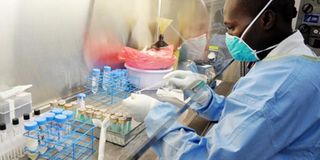Checking the spread of TB

It is usually very hard to know how you got Tuberculosis but, “it is usually triggered by low immunity or poor feeding,” says Jennifer Okalany, a nursing Officer with TB ward at Mulago national Referral Hospital.
Tuberculosis is caused by mycobacterium tuberculosis and one can get it from breathing the air from a person suffering from it which can then be transmitted from crowded places such as prisons, buses and hospitals.
Precautions
“When patients come here for treatment, we usually give them masks because there are those who have already started on treatment and those who are coming here for the first time, says Jennifer Okalany. After two to three weeks on treatment, a TB patient cannot spread the bacteria to other people if he or she has been taking their medicine very well.
“Spitting everywhere aids the spread of bacteria to other people. The patient must have a container where they spit. It must have a tightly fitting cover/lid and contain jik to disinfect. They can always use jik to clean it and thereafter re-use,” she adds.
At the TB ward in Mulago, new patients are usually isolated from those who have already started on drugs and at home, the patient is advised to sleep in a room separate from that of the other family members.
Okalany says, “Proper hygiene is also very important for people with TB. They should have handkerchiefs which they must wash every day and not just leave it there because children may accidentally use it and contract the bacteria as well.”
Once you are travelling by public means say in a bus or taxi, make sure you open the windows to allow proper circulation of air inside. “There could be a person having TB in the bus and once he coughs, the bacteria can spread to everyone there,” says David Kaliisa, a community supervisor for TB patients at Mulago Hospital.
Avoid sharing cups with a TB patient and take anyone with signs of the disease to hospital for checkup. The following may be warning signs to TB according to OKalany;
Morning or evening fever
Night sweats
Loss of weight
Cough that lasts for more than two weeks and the spittle may be bloody.
There are basically three types of TB in Uganda which are TB of the throat, bones and the lungs. Others may include TB of the brain and that of the eye; the commonest and most dangerous being the TB of the lungs and mostly affects people in the central region because there is too much congestion.
Basic TB diagnosis is by using an x-ray examination or taking a sample of spittle from the suspected person for examination in the laboratory.
Treatment and care
The patient must start on the TB medicine (Rifampicin or Isoniazid) as soon as they find out they have it. The treatment and diagnosis test fees at Mulago hospital are free. “After two months on treatment, the pain and some other symptoms have subsided and this becomes a challenge because many patients discontinue their medicines because they no longer feel any ailment,” says Okalany.
Tuberculosis treatment in Uganda used to be strictly eight months but was recently reduced to six months by the ministry of health because a stronger type of TB drugs was introduced. According to the ministry of health, the success rate for TB treatment is 82 per cent.
Kaliisa says, “When patients successfully complete their treatment, we usually give them certificates that show they finished treatment.” There are times when a patient becomes unresponsive to the anti-TB drugs and this is termed as Multidrug-resistance.
World Health Organisation estimates about 12 per cent of the recurrent TB patients become resistant to first line drugs. “This occurs as a result of mismanagement when the patient does not take their drugs as instructed by the doctors, says Etwom. Patients are supposed to take the medicines daily without fail.”
When a patient fails to complete their doses, the TB normally reoccurs and when they are started on the drugs, they tend to become resistant.“When a patient becomes resistant, they are started on second line drugs that are stronger oral tablets, six months of daily injections and the treatment runs for 24 months, ” Etwom adds.
“In Uganda, there have been 520 known cases of second line treatment patients since 2009 and the success rate after they are put on second line treatment is 80 per cent, which is very promising, ” he says. Etwom says, “As a country, second line treatment is 300 times more costly than first time treatment in terms price for the drugs and tests done, the personnel looking after the patients and time.”
The myth
Having TB does not necessarily mean a person has HIV. TB in HIV/Aids patients is as a result of a weakened immune system and once the patient takes the medicine following proper instructions, they can be completely cured of the TB.
Kaliisa says, “We follow-up these patients to their homes but most of them do not want to let us know where they live because in the community, people think that having TB means that a person has HIV/AIDS which is not true. Some people think it is witchcraft or a family disease so they do self-medication and by the time they decide to seek health care, the TB is in its late stages.”




